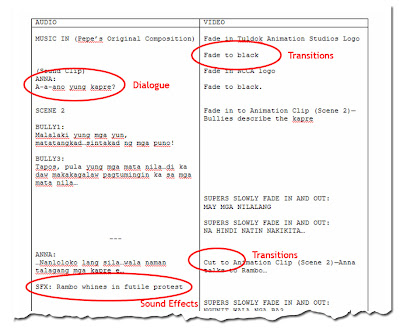C. Character
Once the script and story is done, characters and locations of the story can be visualized by the concept artist depending on the characteristics of each character, the mood of a location, and the director's (that's you!) vision of how each element in the story should look like.
 ROUGH sketches and gestures for my first film "EGG"
ROUGH sketches and gestures for my first film "EGG"these poses need work! wahahaha... oh well... we're all learning.
 Turnarounds for Mr Mani, of "I am the Superhero".
Turnarounds for Mr Mani, of "I am the Superhero".If you notice, I also added some style guides on how hands, eyes, noses should look in this short film too, that way other artists designing other characters for the same film will look like they belong in the same film!
A character comparison is also good to see the proportions of one character with the other!
Once I have more than one character, I get their front views and place them side by side, to check how each of them compares with each other in terms of proportions and size. You may notice the blue circles beside Anna's head, those are about the same size as her head.
When designing characters and making a size comparison, or size comp, I like to measure them by heads than by actual units of measurement. (I wasn't too good in physics and science after grade school!)
next: backgrounds!
in the meantime, check out these amazing character artists and site:
Arthur de Pins
Francisco Herrera
Alberto Ruiz
Character Design blogspot

















































